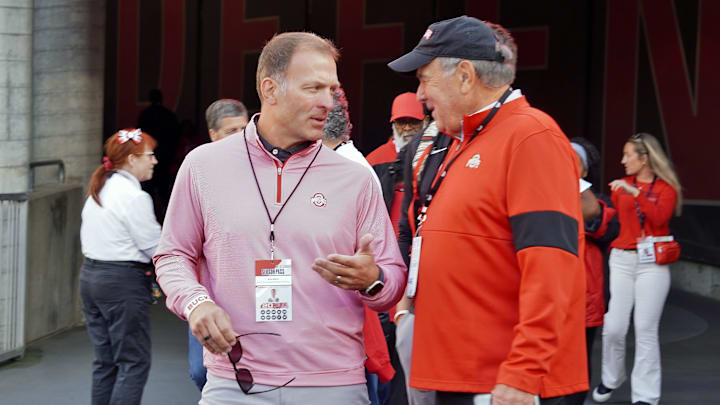The House v. NCAA settlement, finalized on June 6, 2025, was supposed to bring clarity to the chaotic world of name, image, and likeness (NIL) in college sports, but just weeks later, it’s sparking a new wave of conflict.
House plaintiff attorneys Jeffrey Kessler and Steve Berman have accused the NCAA and power conferences of violating the settlement’s terms, specifically targeting the College Sports Commission’s (CSC) guidance on booster-funded NIL collectives. In a fiery two-page letter sent on July 11, 2025, the attorneys demanded that the NCAA retract the CSC’s memorandum, arguing it undermines the settlement by unfairly restricting collectives, according to Yahoo Sports.
Meanwhile, NIL collectives are gearing up for legal action, according to On3’s Pete Nakos, “Lawsuits are about to come.” This escalating battle raises questions about whether Ohio State Athletic Director Ross Bjork was right to bring NIL operations in-house and if his decisions will position the Buckeyes for success in this new era.
The CSC, tasked with enforcing the House settlement, issued guidance on July 10, 2025, stating that booster-backed NIL collectives must meet a “valid business purpose” to have their deals approved by the Deloitte-run NIL Go clearinghouse. This means collectives can’t just pay athletes to attend a school—deals must involve promoting goods or services for profit, like a pro athlete endorsing a product.
Attorneys are planning to escalate the issue to Judge Nathanael Cousins, the settlement’s appointed magistrate, if the guidance isn’t retracted. Collectives, feeling squeezed out, are already consulting lawyers. But the CSC put out a statement about how they believe the guidance was in line with the settlement terms.
“The guidance issued by the College Sports Commission yesterday is entirely consistent with the House settlement and the rules that have been agreed upon with class counsel,” a CSC spokesperson told Dellenger.
The root of the problem lies in the settlement’s goal to shift athlete payments from collectives to schools, which can now share up to $20.5 million annually with athletes. Ohio State’s Ross Bjork, speaking at a press conference on June 6, 2025, embraced this shift, announcing that Ohio State would allocate $18 million for NIL payments across football, men’s and women’s basketball, and women’s volleyball, with $2.5 million for additional scholarships across its 36 varsity sports.
Bjork emphasized the settlement’s clarity, calling it “transformational progress” after years of murky NIL rules. He also expressed confidence in the CSC’s authority, noting that the settlement’s rules, including the “valid business purpose” requirement, were court-approved and backed by arbitration, making legal challenges difficult.
Bjork’s decision to integrate Ohio State’s NIL operations seems prescient given these developments. By bringing NIL Collectives in-house, Ohio State avoids reliance on collectives, which are now under fire. Bjork’s use of analytics to determine position values, guided by experts like defensive coordinator Matt Patricia, mirrors NFL salary cap strategies, ensuring competitive fairness within the $20.5 million cap.
Bjork's commitment to maintaining all 36 varsity sports, despite potential scholarship reductions in some programs, aligns with the settlement’s flexibility while adhering to Title IX. Unlike collectives, which risk legal battles over rejected deals, Ohio State’s in-house model ensures compliance with CSC rules, reducing the chance of athlete suspensions for unapproved deals.
While other college football programs must worry and fret over if their players can be paid, Ohio State is in the driver's seat controlling payments through revenue share and monitoring collectives to not go rouge.
However, the collectives’ pushback could disrupt this system. Their threat of lawsuits echoes concerns raised by industry experts who predicted the settlement’s restrictions would spark litigation.
If it is deemed that the CSC’s actions violate antitrust laws, and the collectives succeed in court, it could loosen restrictions, allowing them to continue operating outside school control. This would challenge Bjork’s strategy, as third-party deals could outpace Ohio State’s capped $18 million, especially in a market like Columbus, where fan passion fuels lucrative opportunities.
Bjork’s confidence in the CSC’s rulings holding up in court may be tested. While he argued the settlement’s legal backing makes challenges unlikely, the attorneys’ letter and the collective deals according to Deloitte’s data, has created a bottleneck that frustrates coaches and athletes alike.
If lawsuits force a retraction of the CSC’s guidance, schools like Ohio State may face pressure to compete with unregulated collective payments, potentially undermining the settlement’s goal of a level playing field.
In the end, Bjork’s proactive move to bring NIL in-house positions Ohio State to navigate this turbulent landscape better than most. If collectives win, Ohio State can cancel the Buckeye Sports Group and have collectives act as they were before. But if the CSC is right and survives court, Ohio State has been set up and ready for this for over a month now.
With collectives preparing to fight, the battle over NIL is far from over. Whether Bjork’s strategy proves to be the right call depends on whether the courts uphold the CSC’s authority or side with collectives, potentially reshaping the rules he’s banking on. For now, Ohio State’s structured approach seems like a smart play in a game that’s still very much in flux.
